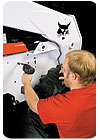
Although cordless tools are becoming increasingly popular on assembly lines today, many manufacturing engineers continue to view them with suspicion. Cordless tools, say the doubting Thomases, are fine for the do-it-yourselfer, but they don’t have enough power for my application. The batteries need replacement too often, and there’s no way they can hold up to constant use and abuse on my shop floor.
The latest cordless tool to hit the market, the IQV series of cordless impact wrenches from Ingersoll Rand Productivity Solutions (Annandale, NJ), was designed specifically to overcome these criticisms.
The series consists of three impact wrenches (1/4-inch, 3/8-inch and 1/2-inch) and two drill-drivers (14.4 volts and 19.2 volts). The tools operate on either nickel-cadmium or lithium-ion rechargeable batteries, which are available in sizes of 7.2, 14.4 and 19.2 volts.
The pistol-grip tool has a chemical-resistant composite housing for maximum structural strength with minimal weight. A steel reinforcement near the trigger and an aluminum ring at the base of the handle protect spots that are vulnerable to cracking when the tool is dropped. The battery locks securely in place with a twisting motion and cannot fall out. Both the hammer case and gear train are made of metal.
“We tested the tool by dropping it from a three-story building-and it survived,” says Christian Corrigan, global marketing manager at Ingersoll Rand Productivity Solutions.
The tools have a variable speed trigger and an electrical brake for optimal control over fastening and loosening. They also have a high power-to-weight ratio. For example, the 1/2-inch tool weighs just 6.2 pounds with the lithium-ion battery or 7.2 pounds with the nickel-cadmium battery. However, it can generate a maximum reverse torque of 360 ft-lb.
Each battery contains a circuit board with a microprocessor. The on-board intelligence optimizes charging, protects the cells from damage, and enhances battery performance. LEDs on the battery face indicate how much charge remains.
One charger accommodates all battery voltages and chemistries. The charger automatically detects the battery voltage and chemistry and chooses the correct charge algorithm. By “reading” the battery, the charger can optimize its charge to improve performance and extend battery life. In addition, the charger has a renew feature that detects the “memory effect” in a battery and restores the cell to like-new capacity. As a result, the batteries can be recharged more than 1,000 times.
The batteries can also be plugged into a battery analyzer. When connected to a PC or laptop computer via a USB cable, the analyzer can tell engineers and service technicians how many times the battery has been charged and when the battery was last charged.
For more information, call 800-376-TOOL or visitwww.irtools.com/cordless.